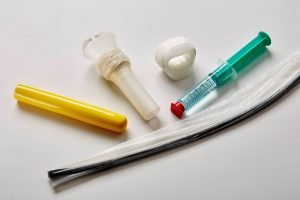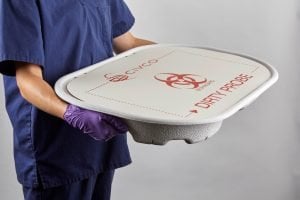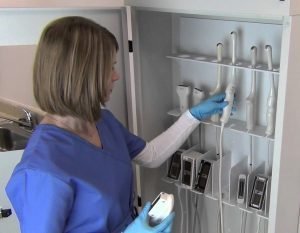Tips for TEE Probe Disinfection

When it comes to disinfecting transesophageal (TEE) probes, the process can be more challenging than other endocavity probes. Let's touch on some of the key highlights here.
TEE PROBES ARE DELICATE (AND EXPENSIVE)
The long insertion tube can be unwieldy to disinfect because of its length and thus vulnerable to damage - even a small tap to the distal tip can damage the probe. You should take extra caution when handling the probe - whether it's rinsing, transporting, or storing.
PROBE COVERS
According to FDA guidance documents, a probe cover or sheath is required every time a probe is used in a semi-critical application. Leading ultrasound system vendors recommend the use of a probe cover. Philips recommends a sterile sheath in addition to patient bite blocks.
every time a probe is used in a semi-critical application. Leading ultrasound system vendors recommend the use of a probe cover. Philips recommends a sterile sheath in addition to patient bite blocks.
TRANSPORTATION
Daily transport of ultrasound probes can pose significant challenges to infection control and probe safety for any department since clean and dirty probes are transported throughout the facility multiple times a day. CIVCO's new TEE Probe Transport Tray helps you to be compliant with national transport standards and OEM guidelines.
 The Joint Commission's recommendation:
The Joint Commission's recommendation:
"Remove the device from the room in a covered container..."1
Probe manufacturers (OEMs) provide specific instructions as well: "To avoid damaging the shaft... Do not bend or coil the flexible shaft of the transducer in less than a 1-ft diameter circle"2
CIVCO's TEE Probe Transport Tray is disposable and made of recyclable water-resistant material. Its reversible clean/dirty lid simplifies your Workflow for safe clean and dirty probe transport, and its special design reduces the risk of damage to the TEE probe and prevents cross-contamination.
SOAKING
During a manual disinfection process, it's imperative to soak the probe for the time advised by the high-level disinfectant manufacturer. Oversoaking the probe can be corrosive. Once in a blue moon, we hear from users who thought that extra soaking time might be better than the instructed time - not true!
RINSING
Be sure to rinse properly. Some disinfectants are more difficult to rinse off the probe. For example, when using an aldehyde-based disinfectant, you need to rinse the TEE probe thoroughly, e.g. 3 separate large volume rinses.
AUTOMATED DISINFECTION![]()
If you'd prefer an automated process, an option exists in an automated disinfection system such as the ASTRA TEE® . The ASTRA TEE allows disinfection of two probes at once, automates the soak and rinsing, and provides a fully automated disinfection log.
PRE-CLEANING
Whether you automate or manually reprocess probes, you must pre-clean your devices properly! First, pre-clean at the bedside and then clean using an enzymatic detergent or according to your probe manufacturer's Instructions for Use.
ELECTRICAL LEAK TEST
As of Dec 31, 2015 the Intersocietal Accreditation Committee (IAC) requires leak testing between every procedure. A damaged probe can lead to black mouth (chemical burning due to improperly rinsed disinfectant) or an electrical shock to the patient (with the probe only inches from the patient's heart).
STORAGE (CABINETS & TIP GUARDS)
The Joint Commission and probe manufacturers recommend storing probes in a manner to protect them from damage and contamination. In addition, TJC recommends that you hang probes vertically in a cabinet and store in a clean, dry environment. Tip guards also help protect the probe's distal tip.
in a manner to protect them from damage and contamination. In addition, TJC recommends that you hang probes vertically in a cabinet and store in a clean, dry environment. Tip guards also help protect the probe's distal tip.
References
- CDC, "Guideline for Disinfection and Sterilization in Healthcare Facilities," 2008
- AIUM, "Guidelines for Cleaning and Preparing External- and Internal-Use Ultrasound Probes Between Patients, Safe Handling, and Use of Ultrasound Coupling Gel," (Approved 5/16/2017)








